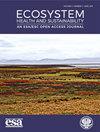基于空间优先级的绿色基础设施网络构建研究策略
IF 3.4
2区 环境科学与生态学
Q1 ECOLOGY
引用次数: 3
摘要
城市扩张对生态系统的破坏导致了环境的恶化,城市变得越来越脆弱。本研究选取郑州市黄河沿岸6个区县作为研究区域。首先,通过形态空间格局分析提取绿色基础设施要素。在城市外围,利用连通性分析评价核心区的重要性,采用最小累积阻力模型提取潜在廊道,利用重力模型识别重要廊道。最后,建立了城市生态系统服务需求评价体系。结果表明:(1)研究区绿色基础设施景观类型为7种。(2)有重要核心17个,潜在廊道136个,城区外重要廊道24个。(3)生态系统服务高需求街区多集中在人口密集、基础设施差的老街区,综合高需求街区有5个。基于绿色基础设施对土地空间的重要性和生态系统服务区域的高需求水平,提出了基于空间保护优先级的绿色基础设施网络规划。本文章由计算机程序翻译,如有差异,请以英文原文为准。
Research strategy for constructing a green infrastructure network based on spatial prioritization
ABSTRACT The destruction of the ecological system caused by urban expansion has led to the environmental deterioration, cities have become increasingly vulnerable. In this study, six districts and counties along the Yellow River in Zhengzhou were selected as the study area. First, green infrastructure elements were extracted by morphological spatial pattern analysis. Then, outside the urban areas, we used connectivity analysis to evaluate the importance of core areas, adopted minimum cumulative resistance model to extract potential corridors, and identified the important corridors by using the gravity model. Finally, in the urban areas, we set up an evaluation system to assess the demands for ecosystem services. The results showed that: (1) Seven landscape types of green infrastructure be identified in study area. (2) There are 17 vital cores, 136 potential corridors, and 24 vital corridors outside the urban areas. (3) The blocks with high demand for ecosystem services are mostly concentrated in the old blocks with dense populations and poor infrastructure, and there are 5 blocks with comprehensive high-demand. Based on identified importance for green infrastructure land space, and high-demand level for ecosystem services areas in this study, a green infrastructure net plan was proposed based on spatial conservation prioritisation.
求助全文
通过发布文献求助,成功后即可免费获取论文全文。
去求助
来源期刊

Ecosystem Health and Sustainability
Environmental Science-Management, Monitoring, Policy and Law
CiteScore
7.10
自引率
2.00%
发文量
40
审稿时长
22 weeks
期刊介绍:
Ecosystem Health and Sustainability publishes articles on advances in ecology and sustainability science, how global environmental change affects ecosystem health, how changes in human activities affect ecosystem conditions, and system-based approaches for applying ecological science in decision-making to promote sustainable development. Papers focus on applying ecological theory, principles, and concepts to support sustainable development, especially in regions undergoing rapid environmental change. Papers on multi-scale, integrative, and interdisciplinary studies, and on international collaborations between scientists from industrialized and industrializing countries are especially welcome.
Suitable topics for EHS include:
• Global, regional and local studies of international significance
• Impact of global or regional environmental change on natural ecosystems
• Interdisciplinary research involving integration of natural, social, and behavioral sciences
• Science and policy that promote the use of ecological sciences in decision making
• Novel or multidisciplinary approaches for solving complex ecological problems
• Multi-scale and long-term observations of ecosystem evolution
• Development of novel systems approaches or modeling and simulation techniques
• Rapid responses to emerging ecological issues.
 求助内容:
求助内容: 应助结果提醒方式:
应助结果提醒方式:


